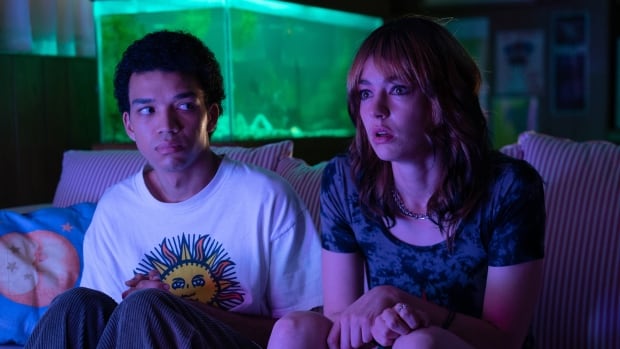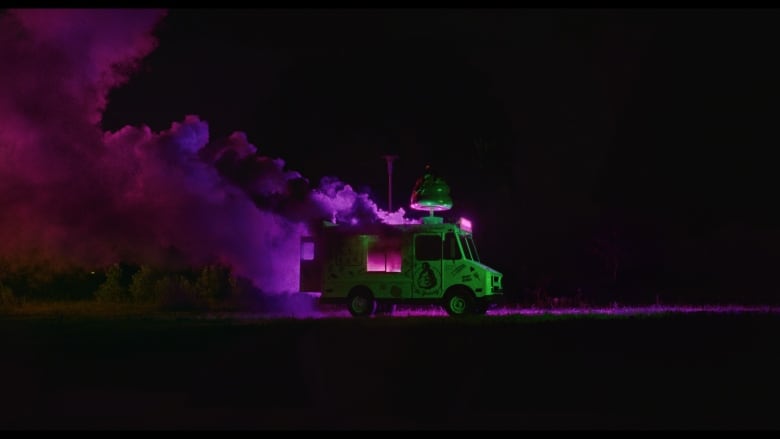
“It feels like someone took a shovel and dug out all my insides. I know there’s nothing there, but I’m still too nervous to open myself up to check,” says Owen, one of the many lost characters in Jane Schoenbrun’s I Saw the TV Glow. “I know there’s something wrong with me — my parents know it, too, even if they don’t say anything.”
It is a good speech, a great speech even, by a writer-director who’s already proved their mastery over the revealing dialogue of adolescence in We’re All Going to the World’s Fair. Here, that mastery continues: made with intention, Schoenbrun’s vision is topped only by obviously deliberate execution in a visually stunning, confidently subtle allegory for the constantly evolving horrors of growing up in a modern hellscape.
But simply knowing what you want to say, and having the talent to say it exactingly, doesn’t mean it’s enjoyable to hear. Because it’s no accident that I Saw the TV Glow is a difficult, hinted at thing; its message lives somewhere between the everyday struggles of lonely adolescents and the overwhelming feeling of destroying oneself to survive growing up transgender.
But in action, it’s a nearly inscrutable metaphor hidden beneath miles of 90s pop-art symbolism. It both asks too much of its audience while offering too few rewards for the effort.
The surface story follows Owen — at the beginning, a timid seventh grader dragged along to election night at the local high school, and initially played by Let the Right One In‘s series star Ian Foreman.
WATCH | I Saw the TV Glow trailer:
Awash in the blue filter that both telegraphs our overall mood and the 90s nostalgia seemingly pumped into the set’s air vents, Owen quietly wanders past pastel-coloured lockers and the Keith Haring inspired-Fruitopia vending machines that more or less defined the decade. Along with the religiously lit CRT-TVs and glow pens, they’re part of the many props trying to send us back in time with a series of unending bonks on the head.
Owen soon stumbles on Maddy, a ninth grader juggling the dual responsibilities of avoiding volunteer duties and doing her best Ghost World impression. But after a brief jab at Owen’s youth causes him to crumple into himself — for the first of many, many times — Maddy softens.
Prying into what turns out to be a strict, sheltered childhood with a bedtime so early he can’t watch the coolest show on TV, she becomes even nicer. Owen is invited over to a secret sleepover in Maddy’s basement so they can stay up to watch The Pink Opaque together, painted in the same staticky light as scattered shouting and implied violence echoes upstairs to sketch a picture of Maddy’s own problems.
Pink Opaque
As they grow (and the Owen role is taken over by Justice Smith) their friendship unfolds in tandem with the events of Pink Opaque, a show about two telepathically linked teenage girls at summer camp.
Another aping of 90s content that, while accurate in broad strokes, is too much a celebration of the style to feel genuine. The too-good and too-modern-to-be-true X-Files Jr. feels more like Adventure Time through a rose-coloured screen than actual memory, and perhaps the sole point where a hiccup in Schoenbrun’s direction makes it difficult to stay immersed in their world.
But it’s enough to hook Owen, hunching over glowing screens to devour Pink Opaque tapes Maddy gives him.
The rest of I Saw The TV Glow jumps up the surrealism by dipping in and out of that TV world until the realities are mixed. What follows is an untangling of those characters’ threads that plumbs the depths of a mystery that viewers can either go into blind, or do some major homework to unpack.
Granted, there are hints throughout. Owen, a Black boy with a white father in a suburbia seemingly devoid of diversity, is closed off from the outside world in virtually every way. He answers the question of whether he likes girls or boys with “I think I like TV shows.” His pivotal moment is an eruptive, guttural scream that he spends the next several minutes apologizing for.
Aside from his late-addition voice overs and storybook-style narration that clears up some of the plot while damaging its overall quality (an explanatory crutch in Schoenbrun’s work that goes all the way back to their pseudo-documentary A Self-Induced Hallucination) Owen stays tight-lipped around nearly everyone.
Waifish workhorse
Smith is well versed in this type of role. In Dungeons & Dragons: Honor Among Thieves, he was gradually dialling up his figurative awkwardness knob. It was turned all the way up to ten in The American Society of Magical Negroes and is inching up to an 11 for this. He appears to be studying for a PhD in mousy, disaffected young men. And sure, the depiction of non-stereotypical Black youth is novel, but a resume whereby he simply stutters and whispers through a non-masculine version of Blackness without variation or insight has diminishing returns of depth.
But the real heart of I Saw the TV Glow is a few layers below that.
An early scene shows Owen under a pink, blue and white playground parachute. Later, he ends a conversation with his concerned mother by spitting on turquoise cotton candy, cowers when his father questions whether Pink Opaque isn’t “a show for girls,” and storms past hallway signs with encouraging words like “pain is weakness leaving the body,” “veni, vidi, vici” and “to thine own self be true.”

Coupled with a collapsing Pink Opaque narrative that literally devolves into characters being buried alive, for a certain crowd, the metaphor of addressing or hiding from gender dysphoria couldn’t be more accessible.
And despite personal anecdotes becoming more of a faux pas in film criticism, I can say everything about this story should be geared toward me: from the living through the decade, racial isolation, dysphoria and paralyzing introversion I should see myself hearteningly echoed in Owen.
But while that opens a door to Schoenbrun’s work, the interior isn’t all that exciting. The surface story of a nostalgic show bleeding into reality honestly limps along, and was done more efficiently in “Pirate Cove,” from Channel Zero, a horror anthology that devoted its entire first season to a decade-specific children’s TV show with uncannily evil overtones.
The era’s affectations here are more a sanctified nostalgia. Films that use the setting to live, not play dress up — like Mean Creek‘s Josh Peck screaming very standard youthful slurs, or Super Dark Times‘ annoyance at poor technology rather than reverence of it — show an era that doesn’t feel improved into obscurity.
And if I Saw the TV Glow were a short film, like Schoenbrun’s last effort, it may have been able to stand on the merit of its central idea. But where films like Skinamarink or Sasquatch Sunset give audiences just enough tools to work out what’s going on — walking the line between stress and boredom all the way to the end — I Saw the TV Glow divides.
Because as beautiful and deliberate as it is, I Saw the TV Glow is too plodding and stretched to make unearthing its point worth it. And for those not primed to those interpretations off the top — or not willing to read analysis beforehand — I Saw the TV Glow may simply exist as a pretty, but plodding, social media style “corecore” post of the 90s.
But as that TikTok trend of mashing seemingly meaningless but evocative imagery together is basically a new form of Dadaism, maybe there’s another explanation for I Saw the TV Glow’s impossible to follow weirdness. With a message that’s clearly there, and Schoenbrun clearly an impressive rising talent, it could just be that I didn’t get it.